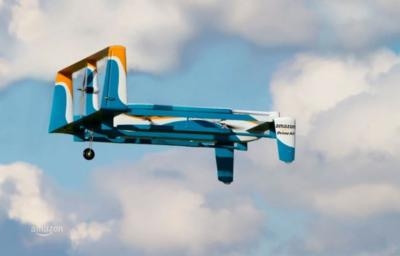Designed To Improve Safety In The Event Of An Emergency
Amazon has received a U.S. patent for a self-destructing delivery drone that is designed to break up in flight in the event of a power failure. The idea is to prevent a heavy drone from causing damage or injury should the aircraft experience a power failure or other in-flight emergency.

The patent is for "Directed fragmentation for unmanned airborne vehicles". The patent abstract describes a UAV consisting of "various components, such one or more motors, batteries, sensors, a housing, casing or shell, and a payload for delivery.
"Additionally, the UAV includes a flight controller and a fragmentation controller. The flight controller determines a flight path and controls a flight operation of the UAV. During the flight operation, the fragmentation controller develops a fragmentation sequence for one or more of the components based on the flight path, the flight conditions, and terrain topology information, among other factors.
"The fragmentation controller can also detect a disruption in the flight operation of the UAV and, in response, direct fragmentation of one or more of the components apart from the UAV. In that way, a controlled, directed fragmentation of the UAV can be accomplished upon any disruption to the flight operation of the UAV."
The patent states that while the UAV is in-flight, the fragmentation controller develops and updates a fragmentation sequence. Among other information, the fragmentation sequence includes a release timing and a release location to fragment away (e.g., release, drop, jettison, eject, etc. away) one or more UAV components in case the flight operation of the UAV is disrupted. The fragmentation sequence can be evaluated and updated over time based on the flight path of the UAV, the ongoing flight conditions for the UAV, and the terrain topology over which the UAV is flying, among other factors. Terrain topology information or data can identify certain preferred locations for dropping one or more of the components of the UAV. For example, the terrain topology information can identify bodies of water, forested areas, open fields, and other locations more suitable for dropping components of the UAV if or when flight operation errors, malfunctions, or unexpected conditions occur.
The fragmentation controller can also detect disruptions in the flight operation of the UAV and, in response, direct fragmentation of one or more components of the UAV apart from the UAV based on the fragmentation sequence. In that way, a controlled, directed fragmentation of various parts of the UAV can be accomplished upon disruption of the flight operations of the UAV or at other desired times. This can result in the UAV, and certain parts of the UAV, landing at more preferable or suitable locations if flight operations are disrupted.
The patent describes conditions under which a drone may encounter unexpected difficulties during the delivery of the shipping container. For example, the UAV can encounter unexpected heat, cold, wind, rain, hail, high or low (e.g., barometric) pressure regions, or other meteorological conditions. These conditions can impact the flight operations of the UAV in various ways. For example, high winds may make it difficult or impossible to control the flight operations of the UAV, for the UAV to arrive at the delivery zone, or for the UAV to return to the airborne carrier. High heat may also result in failure or malfunction of the battery of the UAV, leading to loss of thrust provided by the rotor system. Similarly, other components of the UAV, such as the rotor system, flight control computer, flight sensors, or other components, can unexpectedly malfunction or fail for various reasons.
Regardless of the circumstances surrounding the disruption in flight operation, the embodiments described herein are directed to a controlled sequence for fragmenting away components of a UAV.
(Source: U.S. Patent offices. Image from file)
 Unfortunate... ANN/SportPlane Resource Guide Adds To Cautionary Advisories
Unfortunate... ANN/SportPlane Resource Guide Adds To Cautionary Advisories ANN FAQ: Turn On Post Notifications
ANN FAQ: Turn On Post Notifications ANN's Daily Aero-Term (04.29.24): Visual Approach Slope Indicator (VASI)
ANN's Daily Aero-Term (04.29.24): Visual Approach Slope Indicator (VASI) ANN's Daily Aero-Term (04.28.24): Airport Marking Aids
ANN's Daily Aero-Term (04.28.24): Airport Marking Aids ANN's Daily Aero-Linx (04.28.24)
ANN's Daily Aero-Linx (04.28.24)



